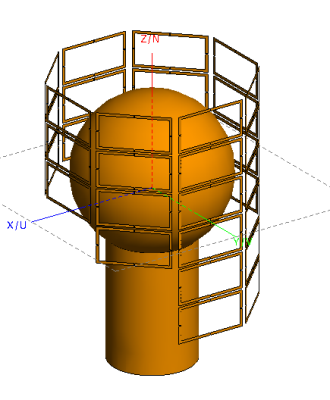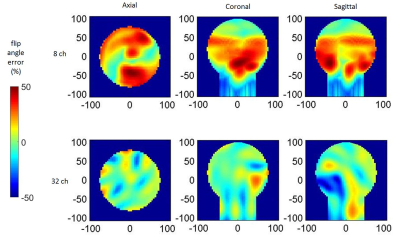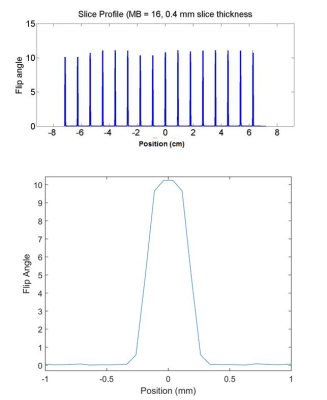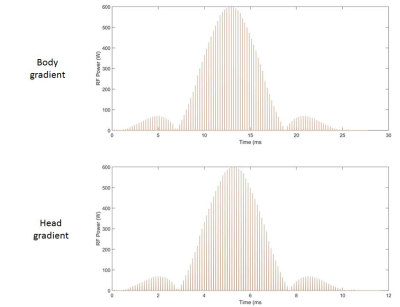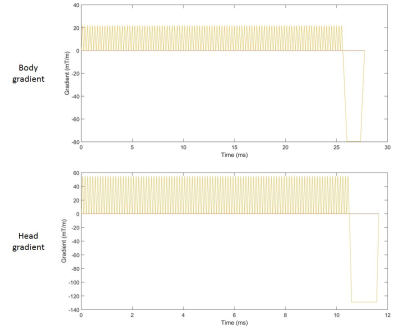3394
pTx-PINS pulses for simultaneous multislice excitation using 32 ch Tx array and insertable head gradient1Stanford University, Stanford, CA, United States
Synopsis
We describe a method for combining the PINS method for SMS excitation with pTx to design pulses that achieve both good B1+ uniformity (15% inhomogeneity over whole volume) and significant multiband factors (MB = 16) at ultra high field strengths (7T, 10.5T). This is enabled by the use of advanced hardware including a 6-row 32 channel parallel transmit array and a high performance head gradient (130 mT/m strength, 1500 T/m/s slew rate). We optimized RF shimming over the whole volume and applied the optimized shim weights at each point in the PINS trajectory. We satisfied very demanding pulse requirements (0.4 mm slice thickness, MB=16, total flip angle inhomogeneity = 15%) with a practical pulse duration (<12 ms) which is >2 times shorter compared to using conventional hardware
Introduction
Simultaneous multislice (SMS) imaging, whereby multiple slices are excited simultaneously and disentangled in reconstruction, is an effective technique for achieving shorter acquisition time or increased slice coverage. The design of SMS RF pulses is difficult due to peak power constraints [1]. At ultra high fields, parallel transmission (pTx) is used to counteract B1 inhomogeneity, but pTx pulses also have higher power than conventional pulses because they exploit destructive interference to achieve flip angle homogeneity. Consequently, combined pTx-SMS pulses designed to achieve uniform SMS excitation at ultra high fields are severely power limited and therefore typically restricted to low multiband (MB) factors (<6). For these reasons, a power efficient approach to pTx-SMS pulse design is needed. We based our investigation on an existing approach for dealing with peak B1 constraints using the power independent of number of slices [2] (PINS) method. Challenges with combining pTx with PINS (hereafter referred to as pTx-PINS) include (a) achieving flip angle uniformity over the entire volume (not just one slice) and (b) covering the entire excitation k-space trajectory with a practical pulse duration. The kT-PINS [3] approach was proposed whereby the kx and ky locations of the points in the PINS trajectory are optimized to achieve flip angle homogeneity; however, the original proposal didn’t exploit parallel transmission and was only applied to thick slices (4 mm). Here we use advanced RF and gradient hardware to tackle two challenges: a 6-row 32 channel transmit coil achieves flip angle uniformity over the whole volume using only RF shimming (without kx-ky encoding) and a head gradient (1500 T/m/s slew rate) [4] results in faster traversal of the gradient blips in the PINS trajectory. Simulation results show dramatic reductions in pTx-PINS pulse duration and improvements in flip angle uniformity compared to using conventional hardware.Methods
We designed pTx-PINS pulses for 10.5T assuming two classes of gradient coils: body gradient with slew rate = 200 T/m/s and head gradient with slew rate = 1500 T/m/s (these values are good approximations of the hardware limits for currently available gradient coils). We also assumed two classes of parallel transmit systems: 8 channel and 32 channel (these represent the most widely available pTx capability in the first case and the most advanced currently available pTx capability in the second case). The target specification for the pulses was MB = 16, slice thickness= 0.4 mm, flip angle = 10 degrees (these demanding specifications anticipate high resolution fMRI using next generation ultra high field MRI systems). The resulting pulses were compared based on their duration and the flip angle inhomogeneity (evaluated over the whole volume) for the two RF arrays and two gradient coils. We used a head-neck mimicking phantom consisting of a sphere located on top of a cylinder, shown positioned within the 32 channel transmit array in Figure 1.Results
With a total of 90 subpulses, a multiband factor of 16 was achieved when exciting coronal slices with 0.4 mm thickness spaced 0.95 cm apart. Using the 8 channel pTx array, the best achievable flip angle inhomogeneity over the whole volume was 34%. With the 32 channel pTx array, 15% homogeneity was achieved using only shimming (no kx-ky encoding). The RF waveform envelope was designed with the SLR algorithm with a time bandwidth product of 4 and the spacing in excitation k-space was 8 cm^-1. The total duration of the pulse was 27.3 ms using the body gradient and 11.9 ms using the head gradient.Discussion
We demonstrate the feasibility of combined pTx-PINS using advanced gradient and RF hardware, and the influence that each type of advanced hardware has on the achieved pulse durations and levels of flip angle inhomogeneity. We succeeded in exciting very thin slices at very high multiband factors while still achieving a clean slice profile and good flip angle uniformity, making this approach applicable for high performance imaging at ultra high fields. We exploited the higher slew rate of the head gradient to reduce pulse duration by a factor of 2.2. Even though the achieved pulse duration is still long, the pulses will be less sensitive to B0 inhomogeneity than the kT-PINS trajectory since the need for kx-ky encoding is eliminated through the use of a 32ch transmit coil. It should also be noted that we have chosen a very demanding target specification to demonstrate performance under worst-case conditions. For more relaxed targets such as thicker slices or reduced MB factor, the resulting pulse duration will be shorter.Acknowledgements
The authors would like to acknowledge research support by GE Healthcare and by NIH P41 EB015891 and NIH 1 U01 EB025144-01References
[1] Simultaneous Multislice (SMS) Imaging Techniques Markus Barth, Felix Breuer, Peter J. Koopmans, David G. Norris, and Benedikt A. Poser. MRM 75:63–81 (2016) [2] Norris DG, Koopmans PJ, Boyacioglu R, Barth M. Power independent of number of slices radiofrequency pulses for low-power simultaneous multislice excitation. Magn Reson Med 2011; 66:1234–1240. [3] kT-PINS RF Pulses for Low-Power Field Inhomogeneity-Compensated Multislice Excitation Anuj Sharma, Samantha Holdsworth, Rafael O'Halloran, Eric Aboussouan, Anh Tu Van, Julian Maclaren, Murat Aksoy, V Andrew Stenger, Roland Bammer, and William A Grissom. ISMRM 2013 [4] Gradient and shim technologies for ultra high field MRI. Simone A Winkler, Franz Schmitt, Hermann Lanes, Josh De Bever, Trevor Wade, Andrew Alejski, Brian K Rutt. Neuroimage 2016Figures
